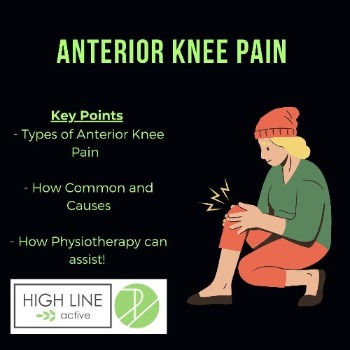Anterior Knee Pain
- Dane Monaghan - Physio

- Jun 29, 2022
- 3 min read
Updated: May 24, 2023

We have many of our clients here at High Line Active Physiotherapy presenting with a variety of knee pain.
Read along to find out more - We love being here for our Richmond community
Types of Anterior knee pain
Anterior knee pain can come in many different variations arising from different affected structures of the knee. It is vital for your physiotherapy to identify the cause of your pain before then addressing it as treatment will differ slightly depending on the exact issue.
Some Diagnosis’ can include

Patellofemoral pain / synovitis / instability
Bursitis: 4 main types displayed →
Hoffa’s Fat Pad Irritation
Quad and Patella tendon loading issues
Osgood Schlatters
Sinding Larsen syndrome
Osteoarthritis
And many others
The complexity of the above causes of anterior pain highlights the importance of having one of the physios here at
High Line Active thoroughly assess the knee prior to treatment
How common? Anterior knee pain or Patellofemoral pain is the #1 reported injury in runners secondary to Achilles tendon pain and shin splints
Annual Prevalence statistics: - 22.7% in the general population experience Patellofemoral pain
- 28.9% in the adolescent population experience Patellofemoral pain
(Smith, et al - 2018) Causes of Anterior Knee Pain The cause of anterior knee pain can vary depending on the presentation so there isn’t one exact cause however the most common causes tend to be based around overuse, muscle imbalances, weakness and joint abnormalities
From what we see in the clinic, the main two causes would be overuse and muscle weakness. This is quite an interesting observation as this involves doing too much or too little.
Overuse injuries
Changes in our workload cause the muscles, joints, tendons and bones to adapt to the new loads being placed on them. It is natural for the body to react to a new stimulus placed on it (i.e. beginning running or running more for example), so understand this is a ‘normal’ reaction to an increase in load HOWEVER if the increase in load is too sharp for too long (too much too soon) then it may be too much for our tendons, muscles, bones or joints to tolerate and therefore it becomes reactive and results in pain or discomfort. This emphasises the significance of talking to your physio about appropriate loading for the knee
Weakness
The following section will be based on the simple principle that the stronger your knee is, the more control you have during movement. If you have poor control, you may place additional forces on the knee above the usual amounts of loads we experience day-to-day. When it comes to conditions like knee osteoarthritis, it is important to remain physically active and improve your strength. Countless studies have shown the positive effects that exercise has on an Osteoarthritic knee when it comes to reducing pain, and improving function and also been shown to have NO effect on long-term progression of their arthritis compared to those who do not exercise regularly (Bosomworth, 2009). So consult your High Line Active physio for more advice on what specific exercises would be beneficial in conjunction with the treatment
Conclusion
The knee is a complex joint with a variety of factors that can contribute to pain or dysfunction. Once your High Line Active Physio has identified the likely cause of your Anterior knee pain then comprehensive treatment planning and exercise prescription will be administered to help reduce your pain and improve your function So come have a chat with one of our High Line Active Physios if this is something that sounds all too familiar Dane and Nicole High Line Active - Physiotherapy (Richmond)








Comments